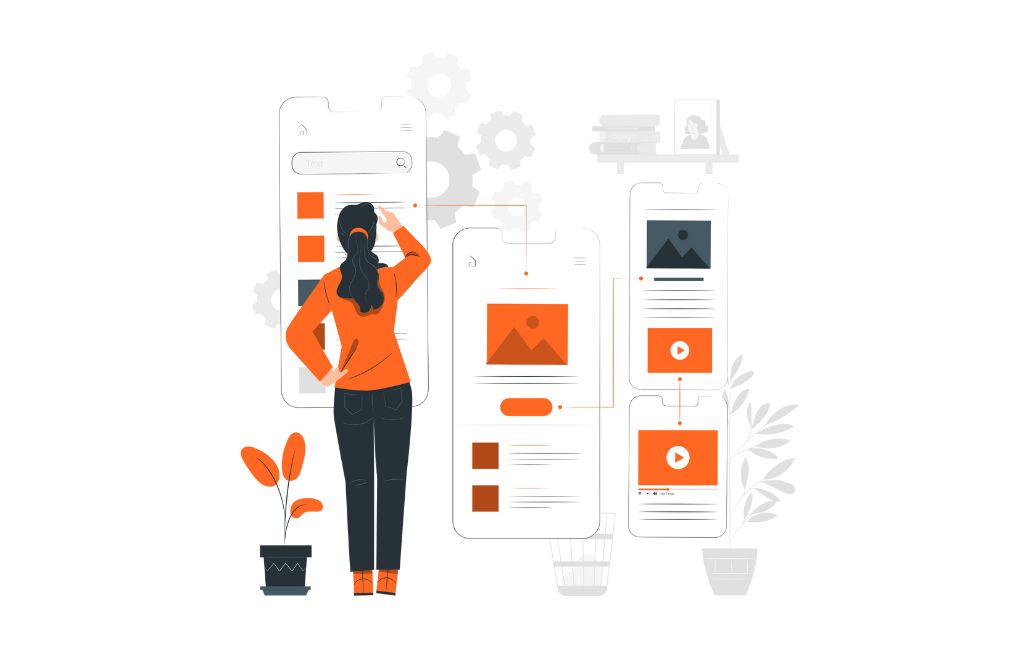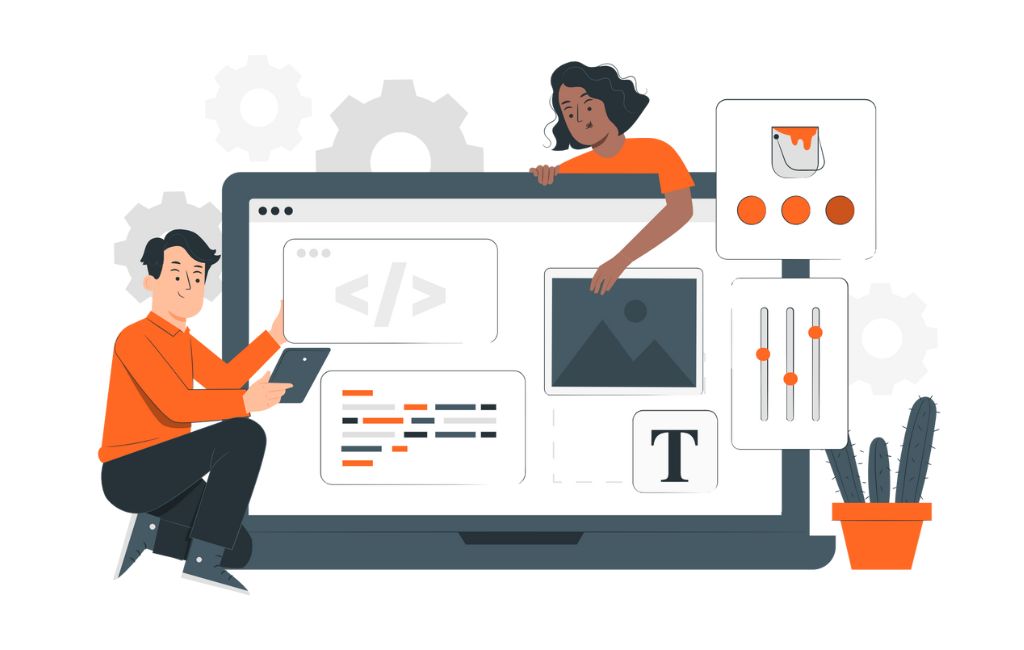In today’s digital age, User Experience (UX) is vital as users have many choices. UX is about how users feel when they use digital products like websites or apps, and it has the power to transform frustration into delight with thoughtful design. Good UX makes users happy, but bad frustrates them. UX Design creates user-friendly products by understanding needs and making things easy, harnessing the potential to turn negative experiences into positive ones. It uses tools like research and testing to craft exceptional digital interactions.
Users get frustrated with complex or slow digital products. Delight comes from smooth, enjoyable interactions. In this blog, we’ll see how UX design turns frustration into delight. We’ll cover user-centered design, emotional design, onboarding, navigation, speed, and communication. We’ll discuss measuring success and share real examples.
By the end, you’ll grasp how UX design brings joy to users and helps digital products succeed. Let’s dive into the world of UX design!
Table of Contents
Understanding User Frustration
Recognizing and comprehending user frustration stands as an essential initial stride in the process of transforming that very frustration into a state of delightful satisfaction.
Common Sources of User Frustration
User frustration can stem from various aspects of a digital product or service. By identifying these common sources, we can gain valuable insights into the pain points that hinder user experiences. Let’s explore some of the key factors contributing to user frustration:
Poor Navigation and Information Architecture
Confusing navigation structures and a lack of clear organization can leave users feeling lost and disoriented. When users struggle to find what they need or encounter dead ends, frustration ensues.
| 💡 Pro tip: Stay in the loop! Use Session Recording Tools to get notified by Java Script Errors, Mouse outs, U-turns, or Rage Clicks. Don’t miss out on optimizing your website! |
Slow Loading Times
In today’s fast-paced world, users have little patience for slow-loading websites or applications. Waiting for pages to load can be a major source of frustration, leading users to abandon the site and seek alternatives.
Cluttered or Overwhelming Interfaces
Complex and cluttered interfaces overwhelm users, making it difficult for them to focus on essential elements or complete tasks efficiently. Too many elements competing for attention can create cognitive overload and frustration.
Inconsistent Visual Design
Inconsistency in visual design, including mismatched colors, fonts, and layouts, can create a disjointed and unprofessional appearance. Such inconsistencies confuse users and weaken brand identity, leading to frustration and a lack of trust.
Lack of User Feedback
When users are uncertain about the outcome of their actions or encounter errors without clear feedback, it can be frustrating and discouraging. Providing meaningful feedback helps users understand their interactions and make informed decisions.
Impact of Frustration on User Behavior and Business Goals
The consequences of user frustration go beyond mere annoyance; they can significantly impact both user behavior and a business’s goals:
Negative User Experience
Frustrated users are more likely to have negative impressions of the product or service, leading to reduced user satisfaction.
Increased Abandonment Rates
Frustration can prompt users to abandon their tasks or leave the website or application altogether. High abandonment rates can result in lost opportunities for conversions and sales.
Decreased User Engagement
Frustration diminishes user engagement and decreases the time spent interacting with the product. Engaged users are more likely to convert, provide feedback, and remain loyal to the brand.
| 💡 Pro tip: Use a Conversion Funnel to measure and see what is blocking your conversions, where visitors leave your site, and where your potential revenue is leaking out. |
Adverse Word-of-Mouth
Frustrated users are more inclined to share their negative experiences with others, impacting a business’s reputation through adverse word-of-mouth.
Impaired Conversion Rates
Frustration can hinder users from completing crucial actions, such as signing up for a service or making a purchase, leading to lower conversion rates.
Reduced Customer Retention
Sustained frustration can result in lower customer retention rates, as users may seek alternatives that offer smoother experiences.
Missed Business Goals
When user frustration becomes pervasive, it can hinder a business’s overall success by impeding the achievement of key objectives.
The Fundamentals of UX Design
Understanding the basics of UX Design is crucial for effortlessly turning frustration into delight. Let’s delve into these fundamentals:
User-Centered Design (UCD) Principles
At the core of effective UX design lies the philosophy of User-Centered Design (UCD). UCD places the user’s needs, goals, and preferences at the forefront of the design process. It involves understanding users through empirical research, empathizing with their experiences, and involving them throughout the design journey. The key principles of UCD include:
Empathy
Developing a deep understanding of users’ motivations, pain points, and behaviors to design with empathy and cater to their needs.
User Involvement
Engaging users in every stage of the design process, from ideation to testing, to ensure that the final product meets their expectations.
Iterative Design
Continuously refining and improving the design based on user feedback and insights to achieve the best possible user experience.
Flexibility
Adapting to different user segments and contexts, as diverse users may have distinct requirements and preferences.
Conducting User Research and Gathering Feedback
User research is the foundation of UX design, providing valuable insights into user behaviors, preferences, and pain points. Techniques such as interviews, surveys, and usability testing help designers understand users’ needs and expectations. Gathering feedback from real users throughout the design process ensures that the product aligns with user requirements and aspirations.
Creating User Personas and Scenarios
User personas are fictional representations of specific user segments, based on research data and common characteristics. Personas help designers empathize with users, design for specific needs, and make informed decisions. Scenarios are narratives that describe how users interact with the product in real-world situations. These scenarios enable designers to envision user journeys and identify pain points to address.
Information Architecture and Content Organization
Information architecture is the structural design of the product, determining how information is organized, labeled, and accessed. A well-organized information architecture facilitates smooth navigation and helps users find what they are looking for effortlessly. The content organization ensures that information is logically categorized, enhancing usability and reducing cognitive load.
Wireframing and Prototyping
Wireframes are low-fidelity representations of the product’s layout and functionality. They provide a visual blueprint of the user interface, allowing designers to test and iterate on the overall structure before adding visual design elements. Prototyping involves creating interactive, high-fidelity mockups that simulate the user experience. Prototypes allow designers to validate design decisions and gather user feedback before development.
Usability Testing and Iterative Design
Usability testing involves observing users interacting with the product and evaluating how well it meets their needs and expectations. Identifying usability issues helps designers refine the design iteratively. The iterative design process involves making incremental improvements based on user feedback and testing, leading to a more refined and user-friendly product.
By incorporating these fundamental UX design principles and practices, designers can create user experiences that resonate with users and solve their pain points effectively. By staying user-centered and iterative throughout the design journey, the resulting products and services are more likely to delight users and contribute to the success of businesses.
The Role of Emotional Design
Emotional design plays a vital role in UX design, and the following points highlight its significance:
Understanding the Connection between Emotions and User Experience
User experiences are inherently emotional. Every interaction with a digital product or service evokes feelings that shape how users perceive and remember their experiences. Emotions influence decision-making, user engagement, and brand loyalty. As UX designers, understanding the connection between emotions and user experience is crucial in creating delightful interactions.
Positive emotions, such as joy, trust, and satisfaction, can enhance user engagement and lead to favorable perceptions of the product or service. Conversely, negative emotions, like frustration, confusion, and disappointment, can drive users away and result in negative associations with the brand. By consciously crafting emotional experiences, designers can build stronger connections with users and foster lasting relationships.
Incorporating Emotional Design Elements
To evoke positive emotions and create delightful user experiences, designers can leverage emotional design elements that resonate with users on a deeper level. Here are some key elements to consider:
Color Psychology and Visual Aesthetics
Colors have the power to evoke specific emotions and moods. By understanding color psychology, designers can strategically choose colors that align with the product’s purpose and appeal to the target audience. Harmonious color schemes and visually pleasing aesthetics contribute to a positive and memorable user experience.
Microinteractions and Animations
Microinteractions are subtle, momentary interactions that provide instant feedback to users. They add a touch of delight and interactivity to the user experience. Animations, when used thoughtfully, can enhance usability, guide user attention, and inject personality into the product. Smooth and purposeful animations contribute to a sense of delight and engagement.
Personalization and Customization
Personalization involves tailoring the user experience based on individual preferences and behaviors. By offering personalized recommendations, content, and experiences, designers can create a sense of ownership and relevance for users. Customization empowers users to adapt the interface to their preferences, leading to a more enjoyable and personalized experience.
Storyselling and Brand Personality
Stories have a profound impact on emotions and memory. Incorporating storyselling elements into the user experience can create a stronger emotional connection with users. Additionally, infusing the brand’s personality into the design adds a human touch, making the product feel more relatable and trustworthy.
By thoughtfully incorporating these emotional design elements into the user experience, designers can create meaningful interactions that leave a lasting positive impression on users. Emotionally engaging experiences are more likely to be remembered and shared, fostering brand loyalty and increasing user satisfaction.
Building a Delightful User Onboarding Experience
In the upcoming section, we will explore the process of creating an enchanting user onboarding experience, effectively turning user frustration into a sense of delight.
Importance of a Smooth Onboarding Process
The user onboarding experience is the user’s first interaction with a digital product or service. It sets the tone for the entire user journey and significantly influences whether users will continue using the product or abandon it. A smooth onboarding process is crucial for creating a positive first impression, reducing user frustration, and guiding users toward successful interactions.
Simplifying Registration and Login Procedures
Registration and login are critical steps in the onboarding process. To minimize user friction, designers should streamline these procedures and offer alternative login methods, such as social media sign-ins or single sign-on options. Avoiding unnecessary form fields and requesting only essential information can speed up the registration process, enhancing user satisfaction.
Interactive and Engaging Tutorials
Interactive tutorials are an effective way to onboard users and introduce them to the product’s features and functionalities. Instead of overwhelming users with long text-based guides, interactive tutorials guide users through the product step-by-step, allowing them to interact and learn in real-time.
Guided Tours and Tooltips
Guided tours and tooltips provide contextual help to users as they explore the product. These non-intrusive prompts can highlight key features, explain functionalities, and offer tips to enhance the user experience. Guided tours help users navigate through the product seamlessly, reducing the chances of confusion and frustration.
Minimizing the Learning Curve
A steep learning curve can deter users from engaging with a product. By designing an intuitive and user-friendly interface, providing clear instructions, and offering progressive disclosure of advanced features, designers can ensure that users can quickly grasp the product’s functionality and start using it with ease.
Streamlining Navigation and Interaction
Creating a harmonious blend of seamless navigation and interaction on your website is pivotal for constructing an impactful UX design.
Designing Intuitive and Clear Navigation
Intuitive navigation is crucial for helping users find what they need quickly and efficiently. Clear and well-organized navigation menus, breadcrumbs, and logical page hierarchies contribute to a smooth user experience. Consistency in navigation across the product ensures that users can easily navigate from one section to another.
Implementing Effective Search Functionality
A robust search functionality allows users to find specific content or products with ease. Implementing predictive search, autocomplete suggestions, and filters enhances the search experience and reduces the time spent on finding relevant information.
Simplifying Forms and Input Fields
Complex forms with numerous input fields can be overwhelming for users. By breaking down forms into smaller sections, using smart defaults, and providing inline validation, designers can make the data entry process less intimidating and minimize errors.
Consistent and Recognizable UI Patterns
Consistency in UI patterns and design elements ensures that users can predict how the product behaves and interact with it confidently. Recognizable icons, buttons, and interactions make the user experience more familiar and reduce the learning curve for new users.
Performance and Speed Optimization
The performance and speed of your website or application play a crucial role in the user experience. Let’s explore the reasons:
Impact of Website/Application Speed on UX
Website or application speed plays a crucial role in user satisfaction. Faster loading times result in reduced wait times and a more seamless user experience. On the other hand, slow-loading pages can lead to frustration, abandonment, and lower engagement.
Techniques for Optimizing Loading Times
Here are the top 3 techniques to optimize loading times:
Image Compression and Lazy Loading
Compressing images and using lazy loading techniques help reduce page load times, especially for image-heavy websites.
Caching and Content Delivery Networks (CDNs)
Implementing caching mechanisms and using CDNs can improve the delivery of content, resulting in faster loading times for users across different regions.
Minimizing HTTP Requests
Reducing the number of HTTP requests by combining CSS and JavaScript files or using sprite sheets can enhance page loading performance.
Feedback and Communication
Feedback and communication play a vital role in user experience, as they provide valuable insights into your users’ experiences, allowing you to continually gather new information.
The Importance of User Feedback Loops
User feedback is invaluable for understanding user needs, identifying pain points, and making informed design decisions. Establishing a feedback loop allows users to provide suggestions and report issues, fostering a sense of involvement and ownership.
Providing Real-Time Feedback on User Actions
Providing immediate feedback for user actions, such as button clicks or form submissions, reassures users that their interactions are registered and acknowledged. Visual cues, loading animations, and success messages create a more responsive and engaging user experience.
Error Handling and Messages with Clarity and Empathy
Error messages should be informative, specific, and presented with empathy. Clearly explaining the issue and offering solutions or guidance helps users recover from errors and proceed smoothly.
Utilizing Contact Points for User Support
Including easily accessible contact points, such as live chat, help centers, or email support, empowers users to seek assistance when needed. Offering responsive and helpful support enhances the overall user experience.
Measuring and Analyzing User Delight
Measuring and analyzing are essential for discerning which strategies are effective and which ones are not.
Key Performance Indicators (KPIs) for UX Success
Defining relevant KPIs, such as user satisfaction scores (e.g., Net Promoter Score), task success rates, and user retention rates, helps measure the success of UX design efforts and gauge user delight.
Conducting User Satisfaction Surveys
Regularly conducting user satisfaction surveys provides direct insights into user perceptions and areas for improvement. Surveys can reveal sentiment, preferences, and pain points, guiding iterative improvements.
Analyzing User Behavior with Analytics Tools
Leveraging analytics tools allows designers to understand user behavior and interactions within the product. Analyzing user flows, drop-off points, and navigation patterns helps identify usability issues and points of frustration.
| 💡 Pro tip: Use a Website Heatmap to see why your CTAs aren’t hitting the mark or why your visitors aren’t converting. Dive into click patterns, scrolling behavior, and segment actions for actionable analysis. |
Iterative Improvements Based on Data Insights
Data-driven decision-making enables designers to prioritize and address pain points systematically. Iteratively improving the product based on data insights fosters continuous enhancement and optimization.
Final Thoughts on the Future of UX Design and It’s Evolving Landscape
In a changing tech landscape, UX design grows vital. To thrive, adopt new tech, grasp user actions, and stay nimble in design. In summary, shifting from user frustration to joy needs devotion, empathy, and user-focused design. Fundamentals, emotional ties, and thoughtful elements craft lasting positive experiences. Smooth onboarding starts well, easy navigation helps, and speed matters. Trust and engagement come from good feedback and communication. KPIs and surveys gauge delight, improving UX. Real cases show success by surpassing user hopes. Adapt and use UX for long-term wins and loyalty. Future UX means personalization, AI, and accessibility, as we aim to exceed expectations. Business triumphs hinge on empathetic, user-driven design. With UX, we create joyful connections for all. Let’s craft experiences that inspire worldwide.
Don't forget, sharing is caring! :)









